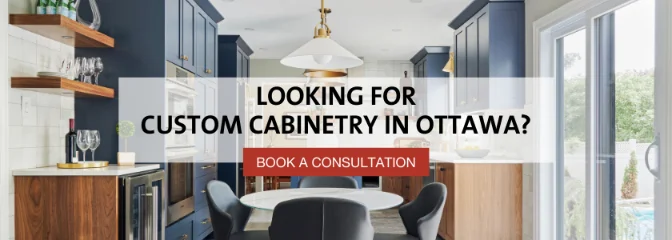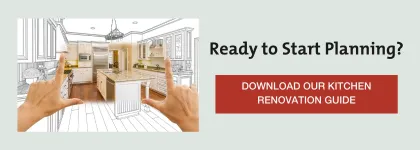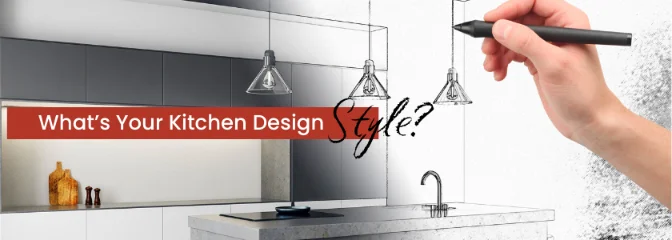19/07/2023 • Blog, Comparisons, Design Tips
Transitional vs. Contemporary Kitchen Design
Estimated Read Time: 6 Minutes
The kitchen is often considered the heart of the home, where families and friends gather to cook, eat, and socialize.
As the years change, so does the world of kitchen design; transforming to reflect evolving lifestyles, style preferences, and technological advancements.
Two of the most popular current kitchen design styles are transitional and contemporary. While they do share some similarities with one another, each school of design has distinctive elements that set them apart.
At Deslaurier, we have over 40 years of experience providing our clients with custom cabinets and kitchen design services. In that time, we’ve helped handcraft hundreds of kitchens to cultivate a transitional or contemporary design style.
With so many moving parts between the two, it can be difficult to know where one design style ends and the other begins.
In this article, we'll explore transitional and contemporary kitchen designs, comparing their similarities and determining their key differences to help you determine if either style is right for your home.
Let’s get started!
| Table of Contents |
What is Transitional Kitchen Design?
Transitional design is best described as a harmonious blend of traditional and modern styles, creating a well-appointed hybrid that seamlessly combines the qualities of old and new elements.
The transitional appearance takes the warm and welcoming nature of traditional kitchens and pairs it with the simplicity found in more modern designs.
-1.png?width=800&height=533&name=MicrosoftTeams-image%20(1)-1.png)
It’s clean and laid-back, and when done correctly, mixing and matching traditional and modern elements is one of the best ways to create a fashion-forward transitional kitchen that will stand the test of time.
With a focus on clean lines, neutral colour palettes, and natural materials, transitional kitchens exude a sense of calm and simplicity, making them a popular choice for those seeking a relaxed yet elegant space.
Contemporary Kitchen Design
Often mistaken for modern design, contemporary kitchen design refers to current and trendy design styles.
In a sense, contemporary design aims to bring warmth back to the kitchen; with bright and open spaces and an emphasis on natural wood elements.
In terms of the three most popular kitchen design “styles” – traditional, transitional, and modern – contemporary kitchens would fall somewhere between transitional and modern.
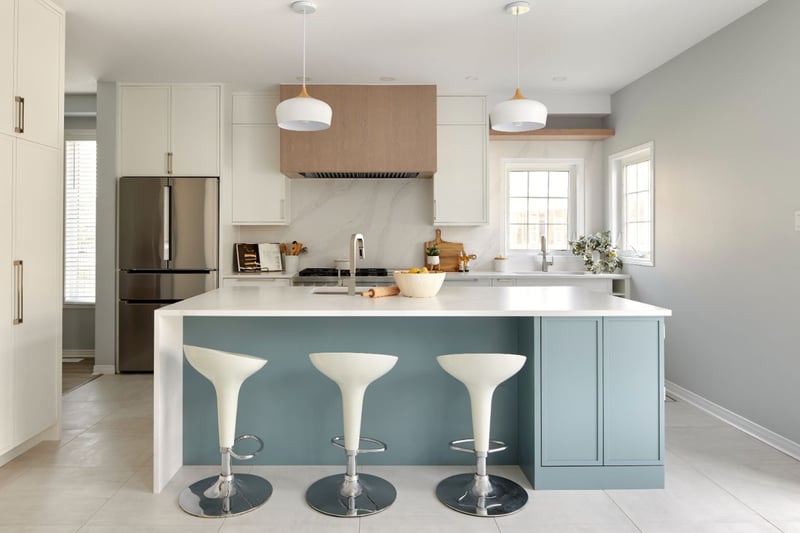
However, contemporary kitchens don’t have the same structured characteristics and rules as the other design styles do, which have established tenets and elements that classify them.
While some contemporary kitchens are designed to be sleek and modern, others incorporate more traditional elements, such as wood accents or decorative ornamentation.
This creates a lot of flexibility which means two contemporary kitchen designs could be far more unique from one another than two modern kitchens might be.
If you’re looking to have more variety and creativity in your kitchen design, opting for a contemporary style is the perfect method of achieving that. It allows you to bring more personality to your space, with added detail and flexibility to the elements you include.
How They’re Similar
Since contemporary kitchen design borrows from transitional design, it should be no surprise that the two styles have several qualities that overlap with one another.
For starters, they both emphasize practical, open kitchen layouts.
Where kitchen design was once about grandiose features and decorative ornamentation, it’s now focused on enhancing the function and efficiency of the space. Something both of these schools of design do in spades.
Large, multi-purpose central islands are a staple in transitional and contemporary kitchens alike. They bring a lot of versatility to a kitchen layout, functioning as a workstation and social hub.
Islands afford more overall cabinet storage and can help spread out features in a kitchen. Appliances like dishwashers, microwaves, and even cooktops can be incorporated into kitchen islands. Not to mention countertop overhang for island seating; perfect for meals and entertaining.
Another key feature of both design styles is their openness, be it through the kitchen’s physical layout or through visual style choices. They often include floating shelving to open up the upper walls so they’re not entirely overwhelmed with a heavy cabinetry look.
Expansive lighting – especially natural lighting – also plays a significant factor. It adds to that feeling of openness and brightens up the space.
How They Differ
While traditional and contemporary kitchen designs share many similarities, they also have some key differences that set them apart.
To start, transitional design is an established practice, while by definition contemporary kitchen design is always changing. As the decades pass, the connotation of contemporary design transforms as well, incorporating current and popular trends of the day.
While contemporary kitchens often borrow from modern, traditional, or even farmhouse, they also utilize transitional design features in a more updated fashion.
For instance, both designs utilize cabinetry with shaker door styles. Shaker-style cabinet doors are constructed using a solid 5-piece frame with a recessed centre panel.
Shaker doors are often considered the quintessential transitional cabinet door style. They’re also quite popular in contemporary kitchens, albeit in a slightly different fashion.
Contemporary shaker doors often implement a much narrower frame than the wider, conventional shaker doors found in transitional designs. This adds a more modern flair to shaker doors by creating a sleeker aesthetic.
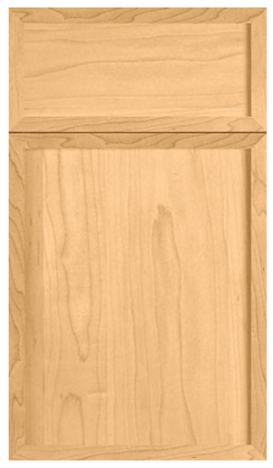
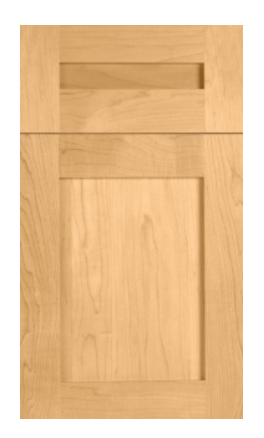
As you can see, our contemporary "Lichfield" shaker door has a far thinner frame than our transitional "Brookfield" shaker door. Compare the rest of our 20 most popular door styles here!
Transitional Features
Similar to the shaker doors, the cabinet hardware in transitional kitchens should be minimal and modest to complement the aesthetic.
Simple knobs and handles in matte black, gold, or silver finishes do just the trick to create that uncomplicated dash of panache.
Quartz, granite, and butcher block are popular for countertop materials. To add even more options to your plate, a large breadth of colours and patterns can work as well: white, cream, soft grey, and even black, complement the clean simplicity of a transitional kitchen.
Speaking of colours, serene and neutral pastel colours help set the transitional mood. With this colour palette, you can achieve a light and airy feel in which the smooth features of the kitchen space easily blend in.
The key to achieving this colour palette is a healthy balance between light and dark, perfectly mixing soft greys, beiges, and charcoals.
Contemporary Features
Marble has always been a luxury item for kitchens and bathrooms, but in the past couple of years, there has been a particularly sharp uptick in marble demand. Homeowners are revisiting the classic, high-end appeal of the all-natural stone with fresh interest.
Heavily veined marble is simultaneously classic and modern; bold and inviting. The organic, fluid and 100% unique patterns on a marble slab are timeless; yet have proven to be quite trendy.
The extravagant veining of marble is a hot commodity in the world of kitchen countertops and backsplashes and has become a go-to for homeowners looking for an intricately designed countertop surface in a contemporary design.
It’s worth noting that marble is a high-end product with a price tag to match. But not to worry, alternative materials such as engineered quartz and Dekton are commonly utilized to achieve the highly-sought after marble aesthetic without breaking the bank!
Unlike the neutral palette of transitional kitchens, contemporary designs embrace bolder colours. Bright and contrasting hues like greens and blues may be used to create focal points or accentuate specific elements.
They also incorporate warm natural wood tones and grain patterns. In fact, combining painted and wood grain cabinets in a two-tone cabinetry design is a staple in contemporary kitchens.
Speaking of natural wood tones, hardwood flooring is a staple of the style.
Contemporary kitchens often use trendy, wider planks to offer a more updated aesthetic over the thinner hardwood of the past. Contemporary designs have become known for using light, gentle wood species like white oak for cabinets and flooring alike.
Which Design Style is Right For You?
In a nutshell, the transitional design style follows stricter guidelines whereas the contemporary design style is more fluid and tolerates “rule-breaking”.
That means contemporary designs can typically be more dynamic and change year after year, incorporating popular trends.
If you want a warm and neutral ambiance, the open and timeless appeal of transitional design is right up your alley.
If you’d rather have more variety and creativity in your kitchen design, opting for a contemporary style might suit you better. It allows you to bring more personality to your space. The added benefit of contemporary design is the ability to include your favourite modern, transitional or traditional-style features while not being restricted to a fixed kitchen style.
Ultimately, choosing a kitchen design will always come down to your lifestyle, style preferences, and budget. Consider these accordingly and you’ll be able to craft the perfect kitchen design to fit your home!
Design with Deslaurier Custom Cabinets
With so much nuance and similarity between the two, it’s no wonder people often get confused when distinguishing transitional kitchens from contemporary designs. We hope this article detailed the differences and helped you better understand which style of kitchen design best suits you and your home.
If you’re looking to install the perfect custom cabinets in your dream kitchen, Deslaurier Custom Cabinets has everything you need! With over 40 years of experience in our name, we provide our clients with a fully customized design process with our talented team of designers.
Book a consultation today with a Deslaurier design expert at our Ottawa Showroom or schedule a virtual meeting!
Interested in becoming an authorized Deslaurier dealer? Visit our Become a Dealer page to learn more! Live outside the area? Visit our Find a Dealer page to connect with a Deslaurier dealer near you!


